Going Public During Lockdown: IPO Insights from Five Biotechnology CFOs
Chief financial officers gather virtually to share the stories of directing their company IPOs over the finish line amid the COVID-19 pandemic.

This fall, in conjunction with CBI-Informa Connect’s Accounting and Financial conference events, Pharmaceutical Executive brought together a group of biotechnology chief financial officers who had recently brought their respective organizations through the IPO process, only one pre-COVID-19 pandemic.
Most of the participants had participated in an IPO previously, some in former roles as bankers or investors. At press time, there were 80 biotech IPOs in 2020 and most of those against the backdrop of the coronavirus crisis in the US, which we will define as starting in mid-March, though clear signs were developing prior.
In the following discussion, we found similarities among executives taking their companies over the IPO line, including their actual hiring—or the hiring of a key executive—as the factor for igniting an IPO; as well as the key milestones to set the foundation for the IPO, which include external vetting of a large accounting firm; establishing a group of trusted outside advisors; and developing a successful company narrative or story to inform their investors and the flow of the S-1 filing.
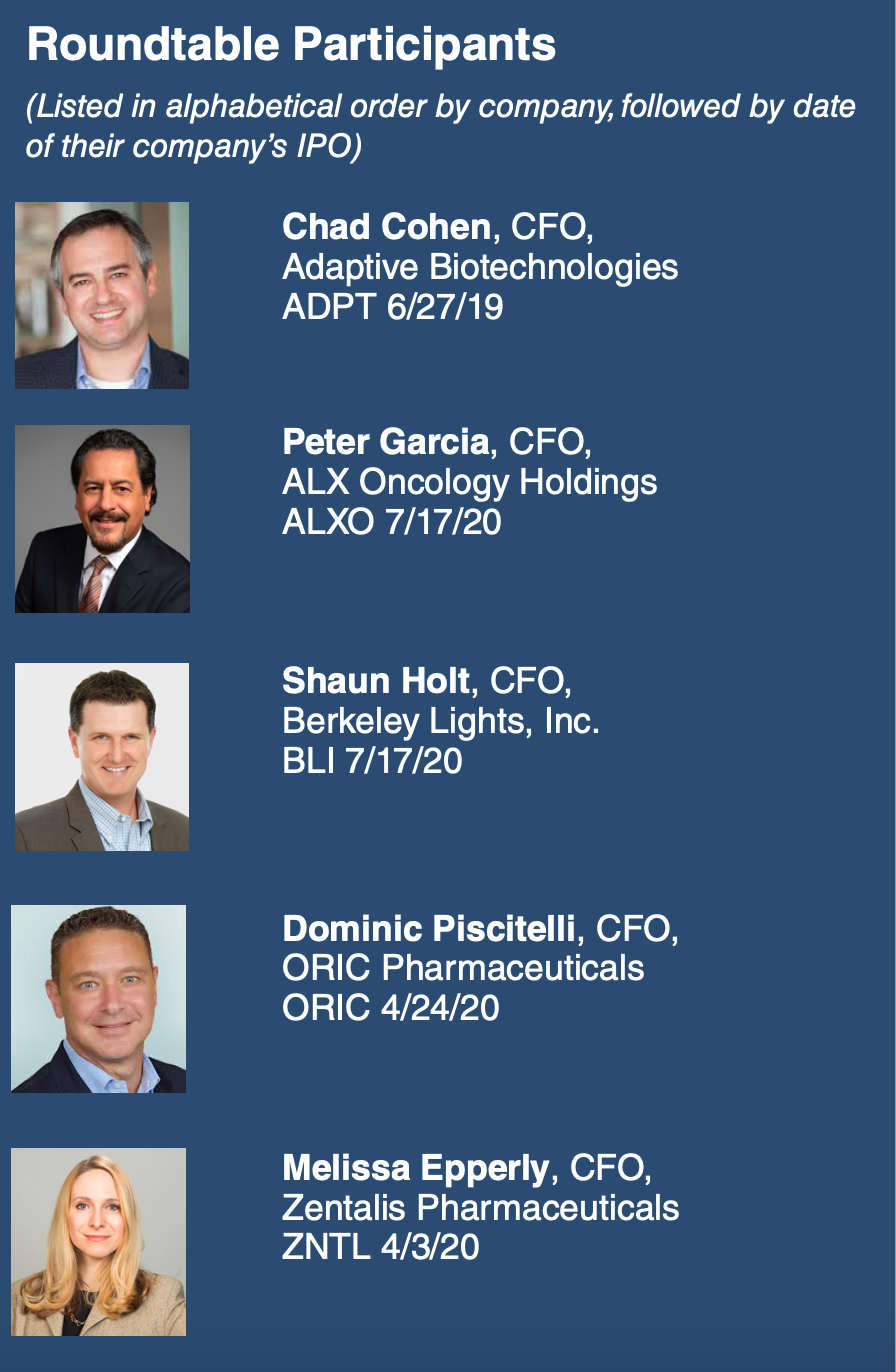
PE: What initial steps did you take to prepare for your company for an IPO?
Chad Cohen, Adaptive Biotechnologies: The long pole items are always the accounting, but also governance and committees. Those committees can be a pretty long pole item for many companies—there are transition rules that allow you to have insiders serve on various independent committees for about a year. But we wanted to satisfy the Nasdaq requirements for independence as much as we could out of the gate. Which meant the role of the audit chair became very important. I was audit chair before I stepped into the role as CFO, and we had never back-filled that role.
Finding a competent committee chairperson for your audit, their comp committee, and making sure the right structure is in place are important.
Peter Garcia, ALX Oncology Holdings: I joined ALX Oncology in January—in the process of closing a Series C—which closed in February and immediately went into IPO mode. The biggest issue was getting our financials audited. We had to move up our audit to get 2019 financials completed by our Big Four audit firm, as well as getting the first quarter financials done.
Our company had never been audited or reviewed on a quarterly basis, so those were the gating items for us to go public because the market was, obviously, very frothy in April, May, June of this year.
Shaun Holt, Berkeley Lights: I joined Berkeley Lights in November 2015 when we were still a development-stage company engineering our initial digital cell biology platform, the Beacon, a high-end platform that is priced on the higher end of the Life Science Tools CapEx pricing spectrum.
Well before we started considering going public, we established the “meet or exceed” mantra, so that we began, very early on, setting the right expectations with our board and private investors, and got in the mode of operation running the company as if it were public.
The other key area was undertaking a process to identify the key risks and constraints within the business, and with growing the business, then putting risk mitigation strategies around those to ensure that when we did go public we could continue to grow the business and execute.
You don’t want to be doing all of these things in parallel to the IPO process. You want to do it well before to set yourself up for success.
Dominic Piscitelli, ORIC Pharmaceuticals: At ORIC, there were some changes at the senior management team level. There was a new CEO brought in mid-2018, and they were just wrapping up a Series C round, with the vision of going public over the next year or so. They had a crossover round in mid-2019. When they decided they wanted to put the pen to paper for the IPO, they decided to hire a CFO and I was brought in to co-lead that effort in September.
The best thing we did—I’m sure we all did—was get organized and understand the various processes that needed to happen and they key constituents. We didn’t have inside counsel at the time, so we leveraged our outside counsel and outlined key workstreams, timelines, and processes to understand the various workflows and assign responsibilities to each workstream. My role was analogous to a quarterback—the person was driving the process and making sure everything was moving along and on the timeline.
We had smaller group meetings with key individuals, and then broader group meetings on a regular basis to touch base and provide a status update.
Another big thing is watching what other companies are doing. We were watching Melissa at Zentalis closely because they were probably one of the first to go out in the middle of the pandemic; so the question was: “What’s going on with Zentalis?” on a regular basis to understand when we should launch, because we had originally planned to launch in mid-March but then everything was upended.
Melissa Epperly, Zentalis Pharmaceuticals: In regard to what Dominic is saying, the companies that went public early in the pandemic have made IPO history. I joined Zentalis in September with the goal of taking the company public as quickly as possible, and we were ready to go by mid-March. I started by calling bankers that I’d worked with or knew of over the last 20-ish years, and we were off to the races preparing a private company to go public.
We potentially would have been able to launch as early as March 16, however, we delayed that by two weeks due to the uncertainty that we were facing with the pandemic. The IPO window was temporarily shut and the VIX (volatility index) was extremely high. IPOs generally don’t occur when the VIX is over 30. In fact, I cannot name a company that has launched an IPO when the VIX was over 30, yet we launched when the VIX was over 55, a record to date.
PE: What external members or resources did you lean on to support your moves?
Cohen: We had an outside counsel team, a large international firm that had been providing support from day one. From an audit perspective, we’d been with the same firm from the beginning, and we had some tricky accounting issues around one of our collaborations and spent a number of sessions with the SEC and its examiners walking them through our position. In terms of having a great external audit team that has national resources to pull from, as well that experience with the SEC, it helps to have the expertise of a Big Four firm.
PE: How did you develop your company’s story? How important was that?
Piscitelli: You need to have a vision and strategy and leverage whatever key assets are in the company. In our case, we were founded by Charles Sawyers, MD, who has been associated with discovery and development of a number of key drugs like XTANDI and ERLEADA, that are on the market today. Our chairman and co-founder, Richard Heyman, PhD, was the founder and CEO of two previous companies (Aragon and Seragon), which were both sold to large pharma.
We had very successful founders and board members and, obviously, leveraged that to become a key component of our story.
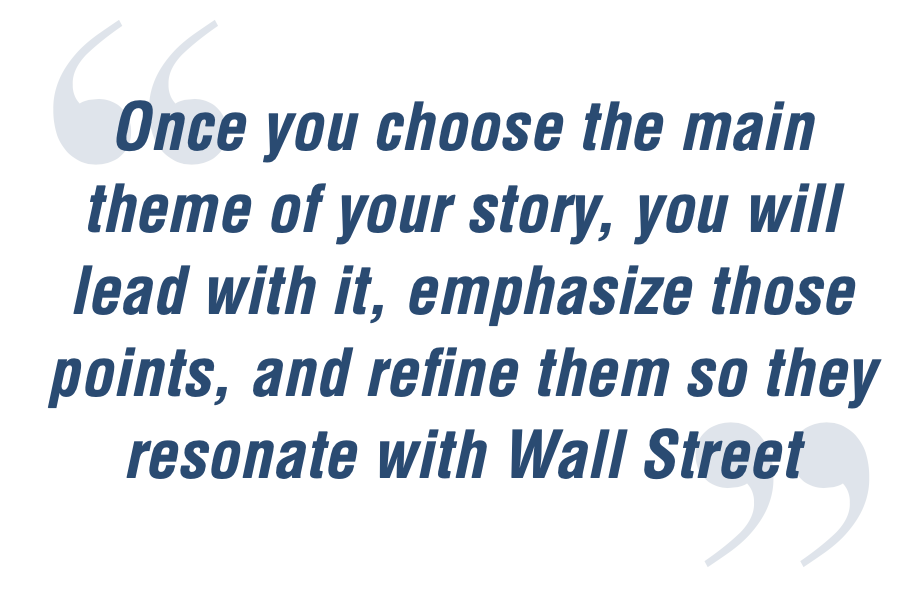
Your story could be how the company was developed; key high-profile assets; prior successes of an experienced management team; your therapeutic area of focus; differentiated platform—all of these attributes go into the mix. And once you choose the main theme of your story, you will lead with it, emphasize those points, and refine them so they resonate with Wall Street.
Holt: Our story started with our founding CEO, the sort of serial entrepreneur and visionary individual who saw a technology and immediately was able to connect the dots to the markets where it could apply and add significant value. With our new CEO, Eric Hobbs, who took over in February of 2017, we took decks from prior fundraising rounds, as well as feedback from the Board, key advisors to the company, and from bankers, obviously, to assess what our strengths and “super powers” are in order to position ourselves appropriately in the sector and markets we serve, but also ensure we were positioning and differentiating ourselves from any other technology out there, and other core comps and competitors in our space as well.
Beyond this, we spent a great deal of time trying to articulate our vision, mission, growth strategy, and business model and how these will evolve over time in such a way that investors could easily understand and model.
Garcia: At ALX, we hired an outside firm to help us with our corporate deck. We received a lot of positive feedback, which made our story easier. We also had the advantage that one of our competitors, Forty Seven, Inc., was being acquired by Gilead for $5 billion, so that laid the foundation in terms of telling our story—only we felt that we had a better story with less toxicity, for example. Those were key things for us.
Cohen: Adaptive, as a platform technology focused on the immune system, we don’t fall into a diagnostic or therapeutic bucket, so we needed to simplify the story to focus on the value and the IP we created around our immune system platform.
That allowed the narrative to unfold around the value inflection points—how we’re creating value; the embryonic state of the company at that point; the partnerships we executed over recent years; the credibility of the platform; and opening up a huge initial TAMS (total addressable market) and potential additional TAMS beyond that, which could drive value longer-term.
PE: What are the key internal finance/accounting roles you hired or needed?
Garcia: I was fortunate enough to have worked with someone who could run circles around most of the accountants that he deals with and I was able to get him in March. With my start in January...we literally hit the ground running.
Cohen: When I started at Adaptive, I brought along Kyle Piskel, who is now our VP of accounting. I knew I needed a great accountant alongside me and he’s been instrumental in helping prepare for the IPO. We also wanted an internal IR (investor relations) person. We initially hired an agency on the IR side because it took us some time to find the right person to be our internal IR, which we just filled.
Holt: My chief accounting officer, Matt Rosinack…I could not have done the IPO process without him. To have a strong number two to help facilitate the process on the financials side, the technical accounting and reporting side, was invaluable. Of course, our entire accounting team played an integral role throughout the process.
We supplemented the team with external help on the technical accounting and SEC reporting sides, leveraging world-class consultants and advisors because we didn’t want to burn head count on an SEC reporting person or other roles, when we were going back and forth on whether to go [public] or not.
Garcia: We definitely needed, and hired, a CPA.
Investor engagement—and executing on carefully formulated business planning—is a work in progress for companies adjusting to the current virtual environment.

PE: What do you think about the timing and the process driving it and keeping it moving?
Holt: Once you decide this is your path, very early on, you need to have a single owner of the process. At Berkeley Lights, that was myself as the CFO; I quarterbacked the process from beginning to end. I had Matt on the financial side. Stuart Merkadeau, our GC, has a wealth of experience with IPOs as well, and was incredible on the legal side, the banking team. And, then, obviously, the CEO. But I was managing the process and all the deliverables, tracking and managing any key constraints or bottlenecks in order to ensure we stayed on track toward our targeted timeline.
While the leadership team was involved early on, we continued with a very concentrated team working on the IPO so as to not disrupt business operations and executing on objectives and revenue targets outside of the IPO process.
It was important to us not to have the IPO be a distraction. So we limited the activities to the core folks and the external support.
One of the negatives with that approach was not bringing the leadership team back in at the appropriate time to ensure they were aligned on the S-1 content before the document was finalized. And we may have waited a week or two too late to do that. That’s one thing I’d do differently—bring in the broader leadership team a little earlier in the S-1 finalization process.
Epperly: The CFO logically is the person driving the IPO. But, as the individual that’s going to make this happen, you have to know who to pull in and when.
It is critical for the success of an IPO to engage with external resources, including investment bankers or other specialists, consultants, and technical accountants, as well as leveraging the knowledge of your internal team. You are responsible for marshaling all the troops together to deliver a successful IPO.
Organizational skills are critical, as it is extremely important to stay on course and remain focused on the reason the company is driving toward an IPO: to fund potentially life-changing science. I found that having a smaller group of core individuals focused on the IPO was very helpful, so the rest of the organization can keep driving the science forward.
Garcia: I would add, for timing, is to identify your timeframe and stick to it. For example, the market, as I said, was frothy, and it felt as if the bankers were trying to force things because of uncertainty. But we were more comfortable to keep with our schedule, related to the SEC filings and such.
PE: Are there specific examples you could share about the pivot to the virtual environment?
Epperly: Normally, an IPO roadshow is eight days long with a weekend in the middle. Since the world was changing so significantly by way of policy, rising COVID cases, and bailouts for different industries, we shortened our roadshow to only four days to lessen the market and macro risks.
Before coming into an investment, it is extremely important for investors to have ample time to conduct diligence on that company and its science. If you are in the investor seat when the IPO deal is launched, you don’t have time to do the necessary research needed to confirm your investment decision.
We definitely benefited from being on the road every day in February. Even toward the end of the month, we still had face-to-face meetings and were able to meet investors, wave to them, or even air elbow bump, since everyone was already getting quite, rightly so, nervous about COVID.
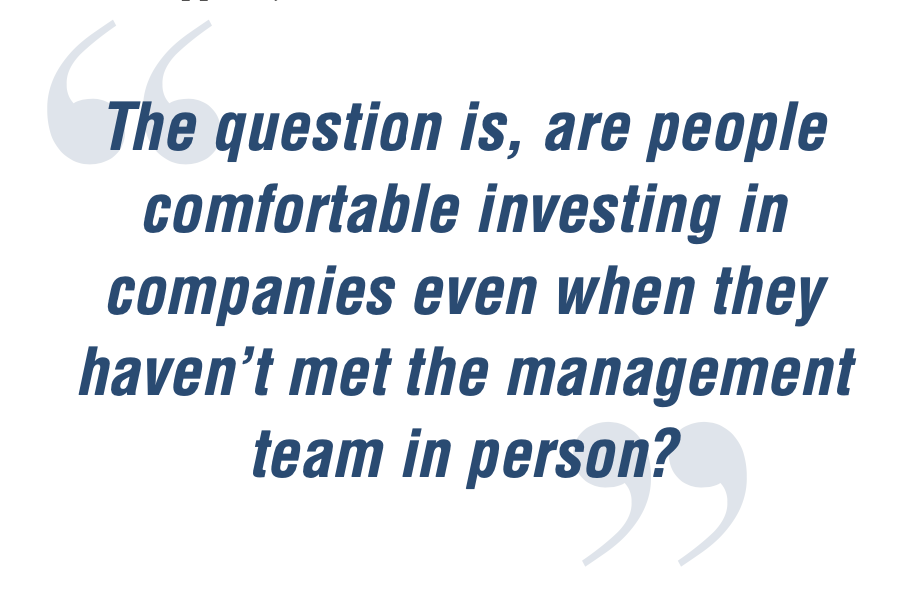
Going forward, everyone will have to adjust to this compressed timeline and not meeting people face-to-face. The question is, are people comfortable investing in companies even when they haven’t met the management team in person? Or can you feel comfortable with a Zoom call?
I think people are getting there, but we’re still only several months into this new world.
If we’re still fully virtual in the future, it will be very interesting to see how companies adapt. Currently, there are many companies that are testing the waters (TTW) virtually. However, for companies that are new to the scene, it’s going to be an exciting challenge for them to operate in a virtual world.
Cohen: I don’t know whether IPOs will ever go back to being the same. The cost of executing an analog IPO has to be a quarter- million to a half-million dollars, and that’s a real cost of capital. It’s money coming out of your coffers. This is an interesting change.
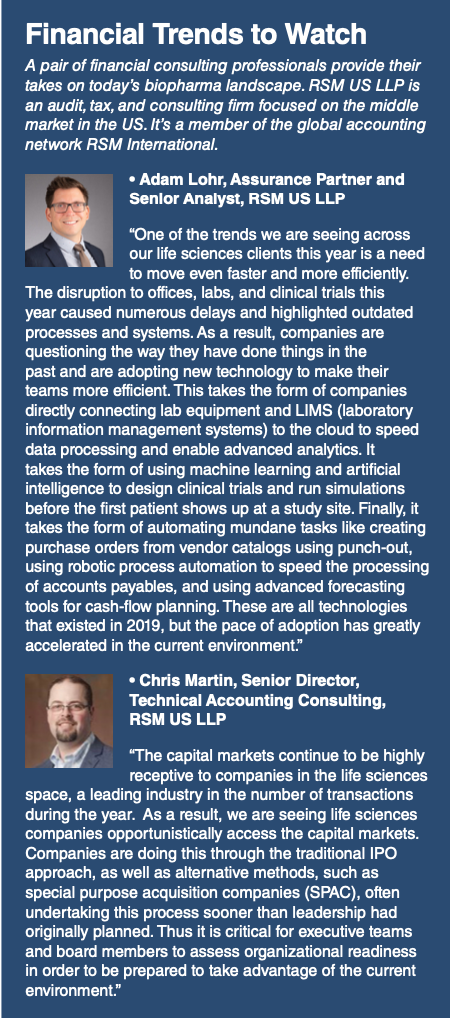
Garcia: At ALX, we did both test the waters and the roadshow all virtually. Since we did do a Series C financing, we had crossover investors that were familiar with us and there were many people familiar with the CD-47 space, which helped.
We were able to do over 60 TTW meetings. With the roadshow, which was really three days, we had one large group meeting and a number of one-on-one meetings for a total of over 100 investors. There’s no way we could have done that previously…the typical roadshow would have been two weeks, but, obviously, the three-and-a-half days look a lot more efficient.
Holt: Accelerating a two-week process to three-and-a-half days, the pricing discussions and aspects around that get dramatically accelerated. There are two weeks of learning in a normal roadshow with respect to how the book is building, how pricing is evolving.
That said, I suggest getting a little more strategic about scheduling certain funds during your roadshow—getting large orders in early to see how the order book is starting to build early on. This helped guide us in terms of how/if we should potentially upsize the round and/or increase price. But everything just gets accelerated, and it makes it hard for the banks as well to go through those learning cycles with respect to how pricing and demand is shaping up.
Piscitelli: There were definitely some learning through the virtual roadshow. I am not sure if we fully revert back to the pre-COVID format of doing a roadshow. I think there’s a happy medium. Maybe you don’t have to go through eight cities, and rather focus more the large cities to be efficient and meet a number of investors.
It’s not efficient to fly to New York from San Diego, take a six-hour flight there, stay overnight for a two-hour meeting, then fly back. We should have always been doing telephone calls or virtual Zoom calls for these types of meetings.
But I do think there’s some balance that some of these conferences will be back in person, where you do have an opportunity to meet new investors or potential partners to foster relationships. This may also be more important for new investors and new management teams.
Lisa Henderson is Pharm Exec’s Editor-in-Chief. She can be reached at lhenderson@mjhlifesciences.com.
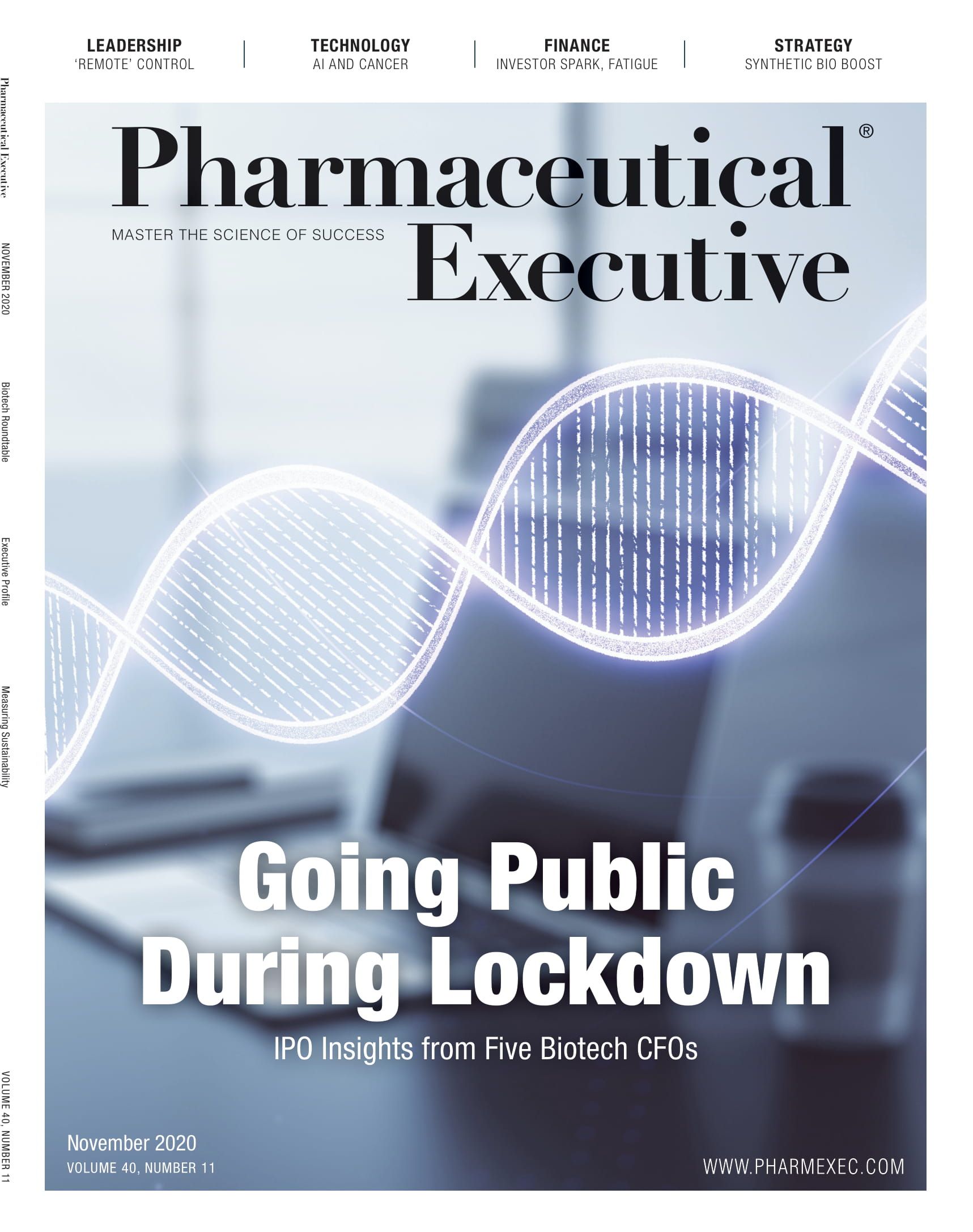
Novo Nordisk, The United Laboratories Ink Exclusive License Agreement for Triple Receptor Agonist
March 25th 2025Under terms of the license agreement, Novo Nordisk will acquire the rights to develop and commercialize UBT251 outside of China for obesity and type 2 diabetes for an upfront payment of $200 million.